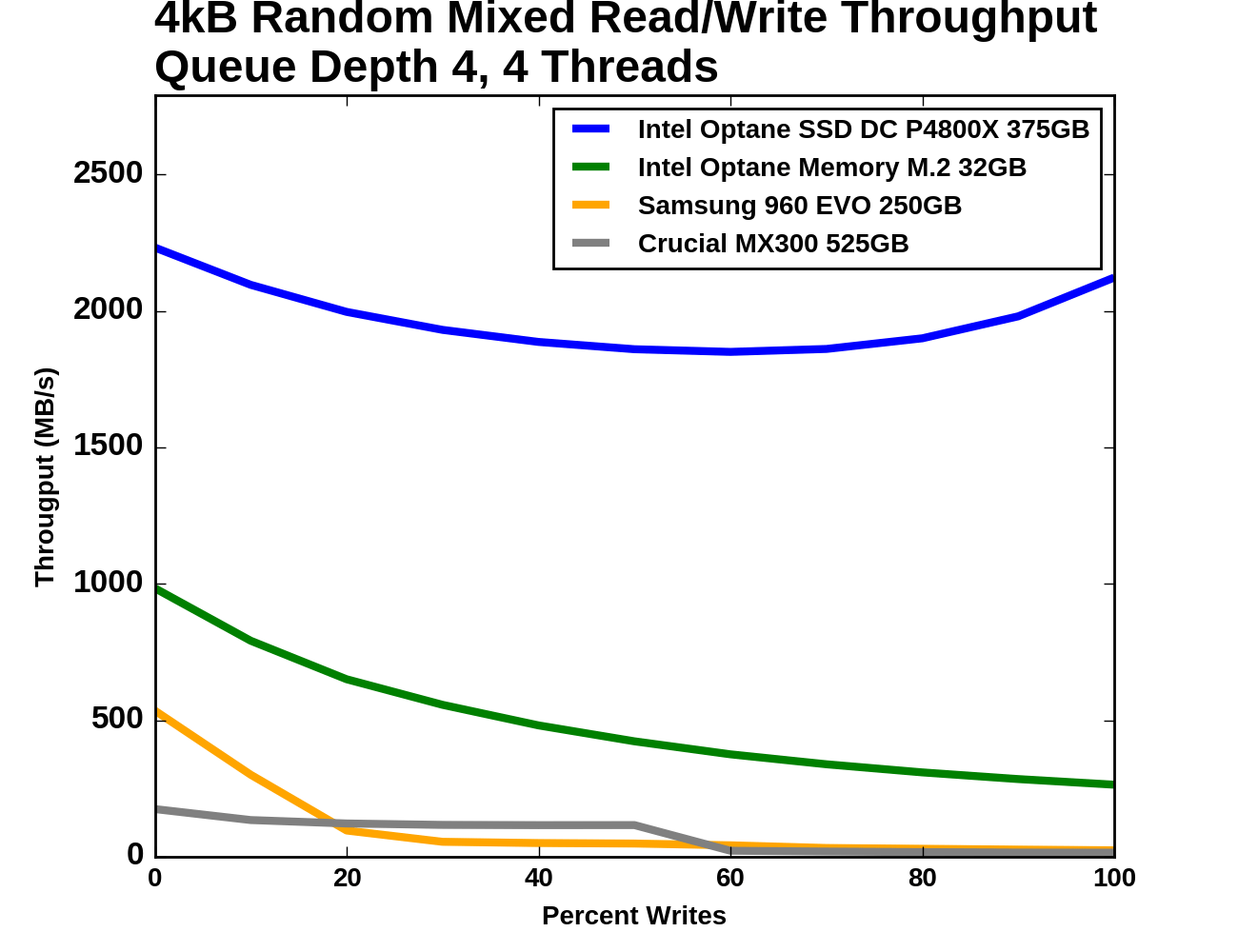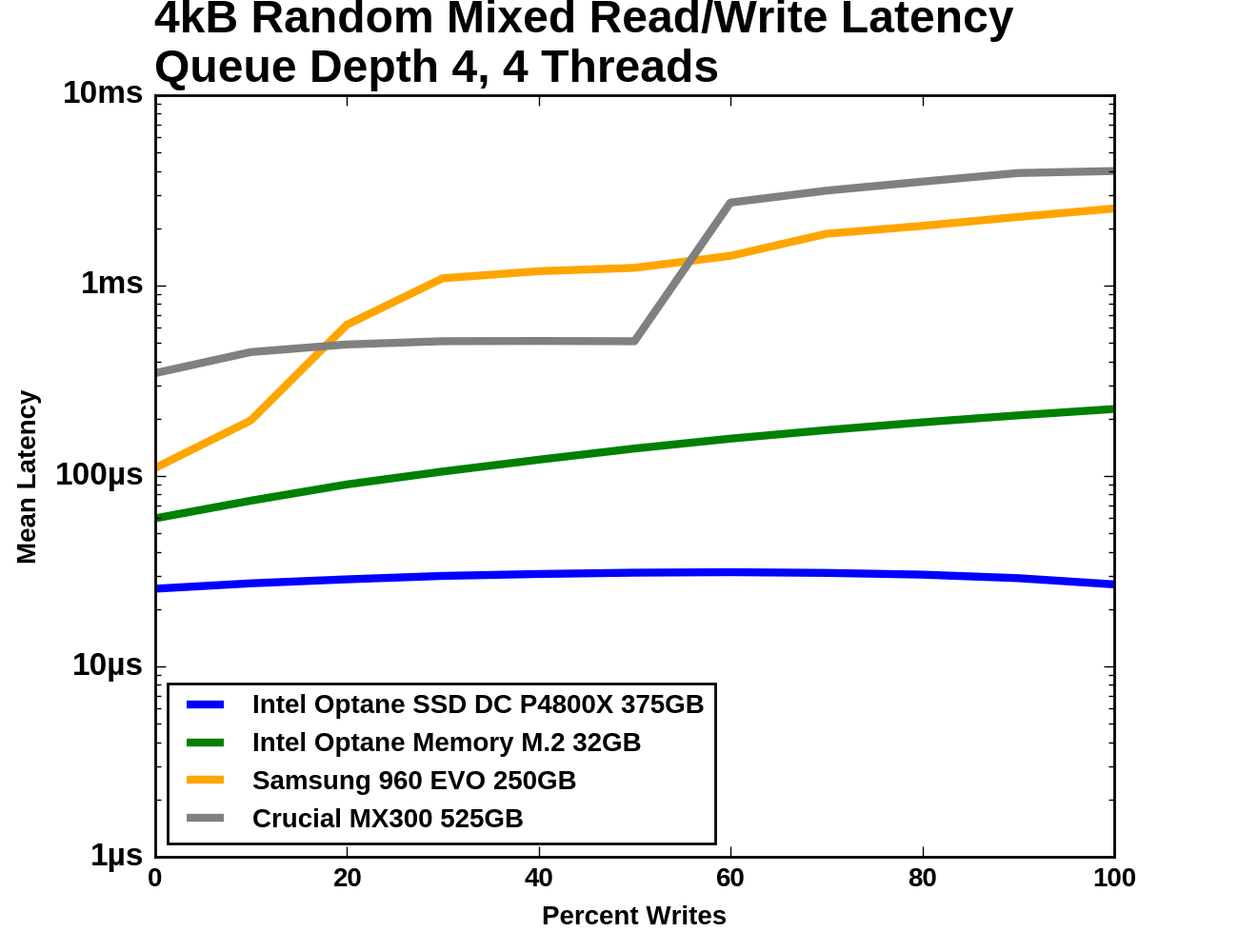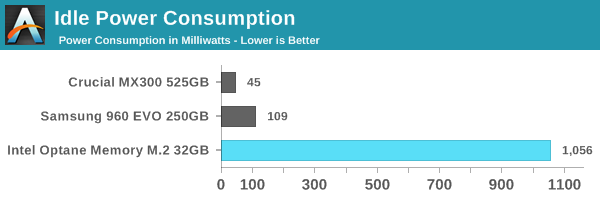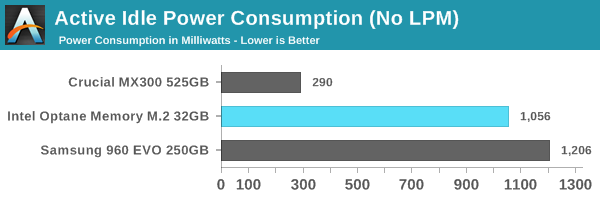The Intel Optane Memory (SSD) Preview: 32GB of Kaby Lake Caching
by Billy Tallis on April 24, 2017 12:00 PM EST- Posted in
- SSDs
- Storage
- Intel
- PCIe SSD
- SSD Caching
- M.2
- NVMe
- 3D XPoint
- Optane
- Optane Memory
Mixed Read/Write Performance
Workloads consisting of a mix of reads and writes can be particularly challenging for flash based SSDs. When a write operation interrupts a string of reads, it will block access to at least one flash chip for a period of time that is substantially longer than a read operation takes. This hurts the latency of any read operations that were waiting on that chip, and with enough write operations throughput can be severely impacted. If the write command triggers an erase operation on one or more flash chips, the traffic jam is many times worse.
The occasional read interrupting a string of write commands doesn't necessarily cause much of a backlog, because writes are usually buffered by the controller anyways. But depending on how much unwritten data the controller is willing to buffer and for how long, a burst of reads could force the drive to begin flushing outstanding writes before they've all been coalesced into optimal sized writes.
This mixed workload test is an extension of what Intel describes in their specifications for the Optane SSD DC P4800X. A total queue depth of 16 is achieved using four worker threads, each performing a mix of random reads and random writes. Instead of just testing a 70% read mixture, the full range from pure reads to pure writes is tested at 10% increments. These tests were conducted on the Optane Memory as a standalone SSD, not in any caching configuration. Client and consumer workloads do consist of a mix of reads and writes, but never at queue depths this high; this test is included primarily for comparison between the two Optane devices.
 |
|||||||||
| Vertical Axis units: | IOPS | MB/s | |||||||
At the beginning of the test where the workload is purely random reads, the four drives almost form a geometric progression: the Optane Memory is a little under half as fast as the P4800X and a little under twice as fast as the Samsung 960 EVO, and the MX300 is about a third as fast as the 960 EVO. As the proportion of writes increases, the flash SSDs lose throughput quickly. The Optane Memory declines across the entire test but gradually, ending up at a random write speed around one fourth of its random read speed. The P4800X has enough random write throughput to rebound during the final phases of the test, ending up with a random write throughput almost as high as the random read throughput.
 |
|||||||||
| Mean | Median | 99th Percentile | 99.999th Percentile | ||||||
The flash SSDs actually manage to deliver better median latency than the Optane Memory through a portion of the test, after they've shed most of their throughput. For the 99th and 99.999th percentile latencies, the flash SSDs perform much worse once writes are added to the mix, ending up almost 100 times slower than the Optane Memory.
Idle Power Consumption
There are two main ways that a NVMe SSD can save power when idle. The first is through suspending the PCIe link through the Active State Power Management (ASPM) mechanism, analogous to the SATA Link Power Management mechanism. Both define two power saving modes: an intermediate power saving mode with strict wake-up latency requirements (eg. 10µs for SATA "Partial" state) and a deeper state with looser wake-up requirements (eg. 10ms for SATA "Slumber" state). SATA Link Power Management is supported by almost all SSDs and host systems, though it is commonly off by default for desktops. PCIe ASPM support on the other hand is a minefield and it is common to encounter devices that do not implement it or implement it incorrectly, especially among desktops. Forcing PCIe ASPM on for a system that defaults to disabling it may lead to the system locking up.
The NVMe standard also defines a drive power management mechanism that is separate from PCIe link power management. The SSD can define up to 32 different power states and inform the host of the time taken to enter and exit these states. Some of these power states can be operational states where the drive continues to perform I/O with a restricted power budget, while others are non-operational idle states. The host system can either directly set these power states, or it can declare rules for which power states the drive may autonomously transition to after being idle for different lengths of time. NVMe power management including Autonomous Power State Transition (APST) fortunately does not depend on motherboard support the way PCIe ASPM does, so it should eventually reach the same widespread availability that SATA Link Power Management enjoys.
We report two idle power values for each drive: an active idle measurement taken with none of the above power management states engaged, and an idle power measurement with either SATA LPM Slumber state or the lowest-power NVMe non-operational power state, if supported. These tests were conducted on the Optane Memory as a standalone SSD, not in any caching configuration.


With no support for NVMe idle power states, the Optane Memory draws the rated 1W at idle while the SATA and flash-based NVMe drives drop to low power states with a tenth of the power draw or less. Even without using low power states, the Crucial MX300 uses a fraction of the power, and the Samsung 960 EVO uses only 150mW more to keep twice as many PCIe lanes connected.
The Optane Memory is a tough sell for anyone concerned with power consumption. In a typical desktop it won't be enough to worry about, but Intel definitely needs to add proper power management to the next iteration of this product.










110 Comments
View All Comments
BrokenCrayons - Monday, April 24, 2017 - link
A desktop Linux distro would fit nicely on it with room for local file storage. I've lived pretty happily with a netbook that had a 32GB compact flash card on a 2.5 inch SATA adapter that had Linux Mint 17.3 on it. The OS and default applications used less than 8GB of space. I didn't give it a swap partition since 2GB was more than enough RAM under Linux (system was idle at less than 200MB and I never saw it demand more than 1.2GB when I was multi-tasking). As such, there was lots of space to store my music, books, and pics of my cat.ddriver - Monday, April 24, 2017 - link
And imagine how well DOS will run. And you have ample space for application and data storage. 32 gigs - that's what dreams were made of in the early 90s. Your music, books and cat pics are just icing on the cake. Let me guess, 64 kbit mp3s right?BrokenCrayons - Monday, April 24, 2017 - link
I'm impressed at the level of your insecurity.mkozakewich - Thursday, April 27, 2017 - link
I've made the decision to never read any comment with his name above, but sometimes I accidentally miss it.DanNeely - Monday, April 24, 2017 - link
Looking at the size of it, I'm wondering why they didn't make a 48GB model that would fill up the 80mm stick fully. Or, and unless the 3xpoint dies fully fill the area in the packages make them slightly smaller to support the 2260 form factor (after accounting for the odds and ends at the end of the stick the current design it looks like it's just too big to fit on the smaller size).CaedenV - Monday, April 24, 2017 - link
Once again, I have to ask.... who on earth is this product for?So you have a cheap $300 laptop, which is going to have a terrible display, minimal RAM, and a small HDD or eMMC drive... are they expecting these users to spring for one of these drives to choke their CPU?
Maybe a more mainstream $5-900 laptop where price is still ultra competitive. What sales metric does this add to which will promote sales over a cheaper device with seemingly the same specs? Either it will have a SSD onboard already and the performance difference will be un-noticed, or it will have a large HDD and the end-user is going to scratch their heads wondering why 2 seemingly identical computers have 4GB of RAM and 1TB HDD, but one costs $100 more.
Ok, so maybe it is in the premium $1-2000 market. Intel says it isn't aiming at these devices, but they are Intel. Maybe they think a $1-2000 laptop is an 'affordable' mass-market device? Here you are talking about ultrabooks; super slim devices with SSDs... oh, and they only have 1 PCIe slot on board. Just add a 2nd one? Where are you going to put it? Going to add more weight? More thickness? A smaller battery? And even after you manage to cram the part in one of these laptops... what exactly is going to be the performance benefit? An extra half a second when coming out of sleep mode? Word opens in .5 sec instead of .8 sec? Yes, these drives are faster than SSDs... but we are way past the point of where software load times matter at all.
So then what about workstation laptops. That is where these look like they will shine. A video editing laptop, or desktop replacement. And for those few brave souls using such a machine with a single HDD or SSD this seems like it would work well... except I don't know anyone like that. These are production machines, which means RAID1 in case of HDD failure. And this tech does not work with RAID (even though I don't see why not... seems like they could easily integrate this into the RAID controller). But maybe they could use the drive as a 3rd small stand-alone render drive... but that only works in linux, not windows. So, nope, this isn't going to work in this market either.
And that brings us to the desktop market. For the same price/raid concerns this product really doesn't work for desktops either, but the Optate SSDs coming out later this year sound interesting... but here we still have a pretty major issue;
SATA3 vs PCIe m.2 drives have an odd problem. On paper the m.2 drives benchmark amazingly well. And in production environments for rendering they also work really well. But for work applications and games people are reporting that there is little to no difference in performance. Intel is trying to make the claim that the issue is due to access time on the controllers, and that the extremely fast access time on Optane will finally get us past all that. But I don't think that is true. For work applications most of the wait time is either on the CPU or the network connection to the source material. The end-user storage is no longer the limiting factor in these scenarios. For games, much of the load time is in the GPU taking textures and game data and unpackaging them in the GPU's vRAM for use. The CPU and HDD/SSD are largely idle during this process. Even modern HDDs keep up pretty well with their SSD brethren on game load times. This leads me to believe that there is something else that is slowing down the whole process.
And that single bottleneck in the whole thing is Intel. It is their CPUs that have stopped getting faster. It is their RAM management that rather sucks and works the same speed no matter what your RAM is clocked at. It is the whole x86 platform that is stagnant and inefficient which is the real issue here. It is time for Intel to stop focusing on its next die-shrink, and start working on a new modern efficient instruction set and architecture that can take advantage of all this new tech! Backwards compatibility is killing the computer market. Time to make a clean break on the hardware side for a new way of doing things. We can always add software compatibility in an emulation layer so we can still use our old OSs and tools. Its going to be a mess, but we are at a point where it needs to be done.
Cliff34 - Monday, April 24, 2017 - link
It seems to me that this product doesn't really make sense for your average consumer. Let's assume you don't need to upgrade your hardware to use Optane memory as cache, why not just spend the money to get a faster and a bigger SSD drive?If that's the case, wouldn't it limited to only a few specific case where someone really need the Optane speed?
mkozakewich - Thursday, April 27, 2017 - link
An extra 4 GB of DDR4 seems to be $30-$40, so getting 16 GB of swap drive for the same price might be a good way to go.I agree that using it for caching seems a little pointless.
zodiacfml - Monday, April 24, 2017 - link
Wow, strong at random perf where SSDs are weak. I guess this will be the drive for me. Next gen please.p2131471 - Monday, April 24, 2017 - link
I wish you'd make interactive graphs for random reads. Or at least provide numbers in a table. Right now I can only approximate the exact values.